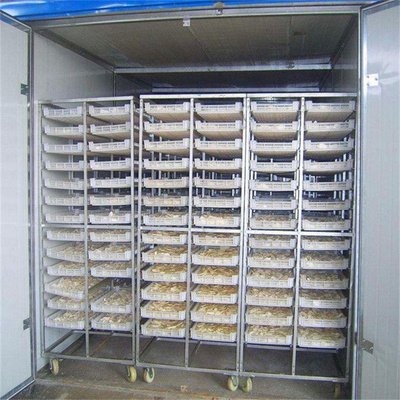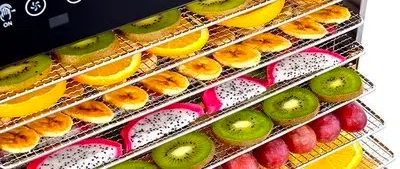
Content Menu
● Introduction to Food Drying Technology
● Understanding Heat Pump Dryers
>> How Heat Pump Dryers Work
● Advantages of Heat Pump Dryers in Food Processing
>> Energy Efficiency
>> Consistent Drying Quality
>> Versatility
>> Reduced Risk of Over-Drying
>> Environmentally Friendly
● Applications of Heat Pump Dryers in Food Industry
>> Fruit Drying
>> Vegetable Drying
>> Herb Drying
>> Meat Drying
● The Science Behind Heat Pump Drying
● Maintenance of Heat Pump Dryers
● Conclusion
● Frequently Asked Questions
>> 1. What is the main advantage of using a heat pump dryer?
>> 2. Can heat pump dryers be used for all types of food?
>> 3. How does a heat pump dryer maintain food quality?
>> 4. Are heat pump dryers environmentally friendly?
>> 5. What types of food are best suited for heat pump drying?
Introduction to Food Drying Technology
Food drying is an ancient preservation method that has evolved significantly over the years. In modern times, food drying machines, particularly heat pump dryers, have become essential tools for food manufacturers, wholesalers, and producers. These machines not only enhance the quality of dried products but also contribute to energy savings and sustainability. This article will explore the workings of heat pump dryers, their advantages in food processing, and how they save energy.

Understanding Heat Pump Dryers
Heat pump dryers operate on a simple yet effective principle: they transfer heat from one place to another using a refrigeration cycle. Unlike traditional dryers that generate heat through combustion or electrical resistance, heat pump dryers recycle heat, making them more energy-efficient.
How Heat Pump Dryers Work
1. Air Intake: The process begins with the intake of ambient air. The dryer pulls in air from the surrounding environment, which is then filtered to remove impurities.
2. Heat Exchange: The filtered air passes through an evaporator coil, where it absorbs heat from the refrigerant circulating within the system. This process cools the refrigerant, causing it to evaporate and absorb heat from the air.
3. Heating the Air: The now-warm air is directed into the drying chamber, where it comes into contact with the food products. The heat from the air helps to evaporate moisture from the food, effectively drying it.
4. Condensation: After passing through the drying chamber, the air, now laden with moisture, returns to the evaporator. Here, it cools down, and the moisture condenses into water, which is collected and drained away.
5. Recycling Heat: The cooled air is then reheated by the refrigerant before being recirculated back into the drying chamber, creating a continuous cycle. This recycling of heat is what makes heat pump dryers so energy-efficient.

Advantages of Heat Pump Dryers in Food Processing
Energy Efficiency
One of the most significant advantages of heat pump dryers is their energy efficiency. By recycling heat, these dryers consume significantly less energy compared to traditional drying methods. This not only reduces operational costs but also minimizes the carbon footprint of food processing operations.
Consistent Drying Quality
Heat pump dryers provide a controlled drying environment, ensuring that food products are dried evenly. This consistency helps maintain the quality, flavor, and nutritional value of the food, which is crucial for manufacturers aiming to meet high standards.
Versatility
Heat pump dryers are versatile and can be used for a wide range of food products, including fruits, vegetables, herbs, and meats. This adaptability makes them an excellent choice for food manufacturers looking to diversify their product offerings.
Reduced Risk of Over-Drying
Traditional drying methods often lead to over-drying, which can negatively impact the texture and taste of food. Heat pump dryers operate at lower temperatures, reducing the risk of over-drying and preserving the integrity of the food.
Environmentally Friendly
By using less energy and producing less waste, heat pump dryers are an environmentally friendly option for food processing. They align with the growing trend towards sustainable practices in the food industry.
Applications of Heat Pump Dryers in Food Industry
Fruit Drying
Heat pump dryers are widely used for drying fruits such as apples, bananas, and berries. The controlled environment ensures that the fruits retain their color, flavor, and nutritional value. For instance, when drying apples, the heat pump dryer can maintain a temperature that prevents browning while effectively removing moisture. This results in dried apples that are not only visually appealing but also taste fresh and flavorful.
Vegetable Drying
Vegetables like carrots, peas, and bell peppers can also be effectively dried using heat pump technology. This method helps preserve the vitamins and minerals that are often lost in traditional drying processes. For example, drying carrots at lower temperatures helps retain their beta-carotene content, making them a healthier option for consumers.
Herb Drying
Herbs such as basil, thyme, and oregano benefit from heat pump drying, which maintains their aromatic properties and essential oils, making them ideal for culinary uses. The gentle drying process ensures that the herbs do not lose their vibrant colors or potent flavors, which is essential for both home cooks and professional chefs.
Meat Drying
For meat products, heat pump dryers provide a safe and efficient way to remove moisture, extending shelf life while ensuring food safety. The controlled environment minimizes the risk of bacterial growth, making it suitable for drying meats like jerky or cured products. This method allows for the production of high-quality dried meats that retain their flavor and texture.
The Science Behind Heat Pump Drying
Understanding the science behind heat pump drying can help food manufacturers optimize their processes. The refrigeration cycle used in heat pump dryers is similar to that of air conditioning systems. It involves the following components:
1. Compressor: This component compresses the refrigerant gas, raising its temperature and pressure.
2. Condenser: The hot, high-pressure gas then moves to the condenser, where it releases heat and condenses into a liquid.
3. Expansion Valve: The liquid refrigerant passes through an expansion valve, where it experiences a drop in pressure, causing it to cool.
4. Evaporator: Finally, the cold refrigerant enters the evaporator, absorbing heat from the incoming air and completing the cycle.
This efficient cycle allows heat pump dryers to operate at lower temperatures while still effectively removing moisture from food products.
Maintenance of Heat Pump Dryers
To ensure optimal performance and longevity of heat pump dryers, regular maintenance is essential. Here are some key maintenance tips:
1. Clean Filters Regularly: Dust and debris can accumulate in the air filters, reducing efficiency. Regular cleaning or replacement of filters is crucial.
2. Inspect Seals and Gaskets: Check the seals and gaskets for wear and tear. Proper sealing ensures that the dryer operates efficiently and prevents heat loss.
3. Monitor Refrigerant Levels: Low refrigerant levels can affect the performance of the dryer. Regular checks and servicing by a qualified technician can help maintain optimal levels.
4. Keep the Condenser Clean: A clean condenser allows for better heat exchange. Regularly inspect and clean the condenser coils to ensure efficient operation.
5. Schedule Professional Servicing: Regular professional servicing can help identify potential issues before they become major problems, ensuring the dryer operates at peak efficiency.
Conclusion
Heat pump dryers represent a significant advancement in food drying technology. Their energy efficiency, consistent drying quality, and versatility make them an ideal choice for food manufacturers and processors. As the demand for sustainable practices in the food industry continues to grow, heat pump dryers will play a crucial role in meeting these needs.

Frequently Asked Questions
1. What is the main advantage of using a heat pump dryer?
The main advantage is energy efficiency, as heat pump dryers recycle heat, reducing energy consumption and operational costs.
2. Can heat pump dryers be used for all types of food?
Yes, heat pump dryers are versatile and can effectively dry a wide range of food products, including fruits, vegetables, herbs, and meats.
3. How does a heat pump dryer maintain food quality?
By providing a controlled drying environment, heat pump dryers ensure even drying, preserving the flavor, color, and nutritional value of the food.
4. Are heat pump dryers environmentally friendly?
Yes, they are environmentally friendly as they consume
5. What types of food are best suited for heat pump drying?
Fruits, vegetables, herbs, and meats are all well-suited for heat pump drying due to the technology's ability to preserve quality and extend shelf life.












